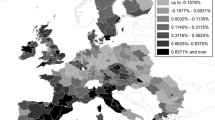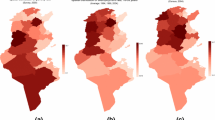Abstract
This chapter examines regional economic conditions and their effects on interregional population redistribution patterns in Russia. After reviewing striking changes in population flows before and after the collapse of the former Soviet Union, an application of the gravity model on population migration in Russia is presented using a newly obtained interregional in- and out-migration flow matrix from 1990 to 2013, which were supplied by Rosstat (formerly Goskomstat). The analysis compared factors affecting migration patterns in the Soviet era to modern Russia, focusing on geographical factors, specifically, the attractiveness of resource-mining regions. The analysis clearly showed major changes in the effect of governmental investment in determining migration flow before and after the collapse of the Soviet Union.
Revised from Center for Economic Institutions Working Paper Series, No. 2016–2, pp. 1–31, May 2016, “Inter-regional Population Migration in Russia Revisited: Analysis on Origin-to-Destination Matrix, 1990–2013” by Kazuhiro Kumo. With kind permission of the Institute of Economic Research, Hitotsubashi University, Japan. All rights reserved.
Access this chapter
Tax calculation will be finalised at checkout
Purchases are for personal use only
Similar content being viewed by others
References
Andrienko, Y., & Guriev, S. (2004). Determinants of interregional mobility in Russia: Evidence from panel data. Economics of Transition, 12(1), 1–27.
Braithwaite, J. (1995). The old and new poor in Russia: Trends in poiverty (ESP Discussion Paper Series No.21227). World Bank.
Brown, A. N. (1997). The economic determinants of the internal migration flows in Russia during transition (William Davidson Institute Working Paper No. 89).
Cole, J. P., & Filatotchev, I. V. (1992). Some observations on migration within and from the former USSR in the 1990s. Post-Soviet Geography, 33(7), 432–453.
Dmitrieva, O. (1996). Regional development: The USSR and after. London: Palgrave Macmillan.
Eliseeva, I. I. (Ed.). (2006). Demografiia i statistika naseleniia [Demography and statistics of population]. Moscow: Finansy i statistika (in Russian).
Federal’naia sluzhba geodezii i kartografii Rossii. (1998). Geograficheskii atlas Rossii [Geographical Atlas of Russia]. Moscow: Roskartgrafiya (in Russian).
Gerber, T. P. (2005). Individual and contextual determinants of internal migration in Russia: 1985–2001. Madison: University of Wisconsin. https://www.researchgate.net/publication/228375599_Individual_and_Contextual_Determinants_of_Internal_Migration_in_Russia_1985-2001 (mimeo).
Gerber, T. P. (2006). Regional economic performance and net migration rates in Russia, 1993–2002. International Migration Review, 40(3), 661–697.
Goskomstat, R. (2004), Ekonomicheskie pokazateli raionov krainego severa i prirazhnennykh k nim mestnostei za yanvar–mart 2004 goda [Economic indicators of extreme north regions and equivalent regions from January to March in 2004]. Moscow, Goskomstat Russia (in Russian).
Greenwood, M. J. (1991). New directions in migration research: Perspectives from some north American regional science disciplines. Annals of Regional Science, 25(4), 237–270.
Greenwood, M. J. (2010). Some potential new directions in empirical migration research. Italian Journal of Regional Science, 9(1), 5–17.
Greenwood, M. J., & Hunt, G. L. (2003). The early history of migration research. International Regional Science Review, 26(1), 3–37.
Guriev, S., & Vakulenko, E. (2015). Breaking out of poverty traps: Internal migration and interregional convergence in Russia. Journal of Comparative Economics, 43(3), 633–649.
Hill, F., & Gaddy, C. G. (2003). The Siberian curse: How communist planners left Russia out in the cold. Washington, DC: Brookings Institution Press.
INGIT. (2002). Vse goroda Rossii 2002: Bol’shaia entsiklopediia geograficheskikh kart [All the cities in Russia: Encyclopedia of geographical maps]. St. Petersburg: INGIT (in Russian).
Ivanova, P. (1973). O rzavitii vostochnykh raionov i obespechenii ikh rabochei siloi (On the development of east regions and the maintenance of its labor power). Voprosy ekonomiki (Problems of Economics), (1), 40–48 (in Russian).
Kuboniwa, M. (2014). A comparative analysis of the impact of oil prices on oil-rich emerging economies in the pacific rim. Journal of Comparative Economics, 42(2), 328–339.
Kumo, K. (2003). Migration and regional development in the Soviet Union and Russia: A geographical approach. Moscow: Beck Publisher Russia.
Kumo, K. (2007). Inter-regional population migration in Russia: Using an origin-to-destination matrix. Post-Communist Economies, 19(2), 131–152.
Lewis, R. A. (1969). The postwar study of internal migration in the USSR. Soviet Geography, 10(4), 157–166.
Matthews, M. (1993). The passport society: Controlling movement in Russia and the USSR. Oxford: Westview Press.
Milovanov, E. V. (1994). Voprosy ekspruatatsiia Dal’nego Vostoka [Problems in exploitation of the far east]. Ekonomicheskaia zhizni Dal’nego Vostoka, 3, 37–41 (in Russian).
Mitchneck, B. A. (1991). Geographical and economic determinants of interregional migration in the USSR: 1968–1985. Soviet Geography, 32(3), 168–189.
Moiseenko, V.M. (2004), Snizhenie masshtabov vnutrennei migratsii naseleniya v Rossii: opyt otsenki dinamiki po dannykh tekushchego ucheta (Decrease in the scale of internal migration in Russia: trial assessment of the dynamics on current accounting data). Voprosy statistiki, 6, 47–56.
Oshchepkov, A. I. (2007), Mezhregional’naia migratsiia v Rossii [Inter-regional migration in Russia]. Moscow: Higher School of Economics (mimeo) (in Russian).
Perevedentsev. (1966). Migratsiia naseleniia i trudovye problem Sibiri [Population migration and the labor problems in Siberia]. Novosibirsk: Nauka (in Russian).
Sevruka, M. A. (2006). Rossiia: federal’nye okruga i region (geografiia, nedra, istoriia, naselenie, religiia, vlast’, ekonomika, sotsial’naia sfera, dostoprimechatel’nosti, strategiia razvitia). Entsiklopediia [Russia: Federal districts and regions (geography, soils, history, population, religion, politics, economy, social sphere, attraction, development strategy). Encyclopedia]. Moscow: Sodruzhestvo.
Shcherbakova, E. (2015). Demograficheskie itogi i polugodiia 2015 goda [Demographic consequences of the first half of 2015]. Demoskop Weekly, No.655–656 (in Russian).
Sonin, M. (1980). Razvitie narodonaseleniia [Population development]. Moscow: Statistika (in Russian).
Thompson, N. (2005). Migration and resettlement in Chukotka: A research note. Eurasian Geography and Economics, 45(1), 73–81.
Vakulenko, E. S. (2014). Does migration lead to regional convergence in Russia? (Higher School of Economics Research Paper No.WP-BRP-53/EC/2014). Moscow.
Vakulenko, E. S., Mkrtchyan, N. V., & Furmanov, K. K. (2011). Econometric analysis of internal migration in Russia. Montenegrin Journal of Economics, 7(2), 21–33.
Vishnevskii, A. G. (Ed.). (2014). Naselenie Rossii 2012 [Population of Russia in 2012]. Moscow: Izdatel’skii dom Vysshei shkoly ekonomiki (in Russian).
Author information
Authors and Affiliations
Copyright information
© 2017 The Author(s)
About this chapter
Cite this chapter
Kumo, K. (2017). Interregional Migration: Analysis of Origin-to-Destination Matrix. In: Demography of Russia. Studies in Economic Transition. Palgrave Macmillan, London. https://doi.org/10.1057/978-1-137-51850-7_8
Download citation
DOI: https://doi.org/10.1057/978-1-137-51850-7_8
Published:
Publisher Name: Palgrave Macmillan, London
Print ISBN: 978-1-137-51849-1
Online ISBN: 978-1-137-51850-7
eBook Packages: Economics and FinanceEconomics and Finance (R0)




